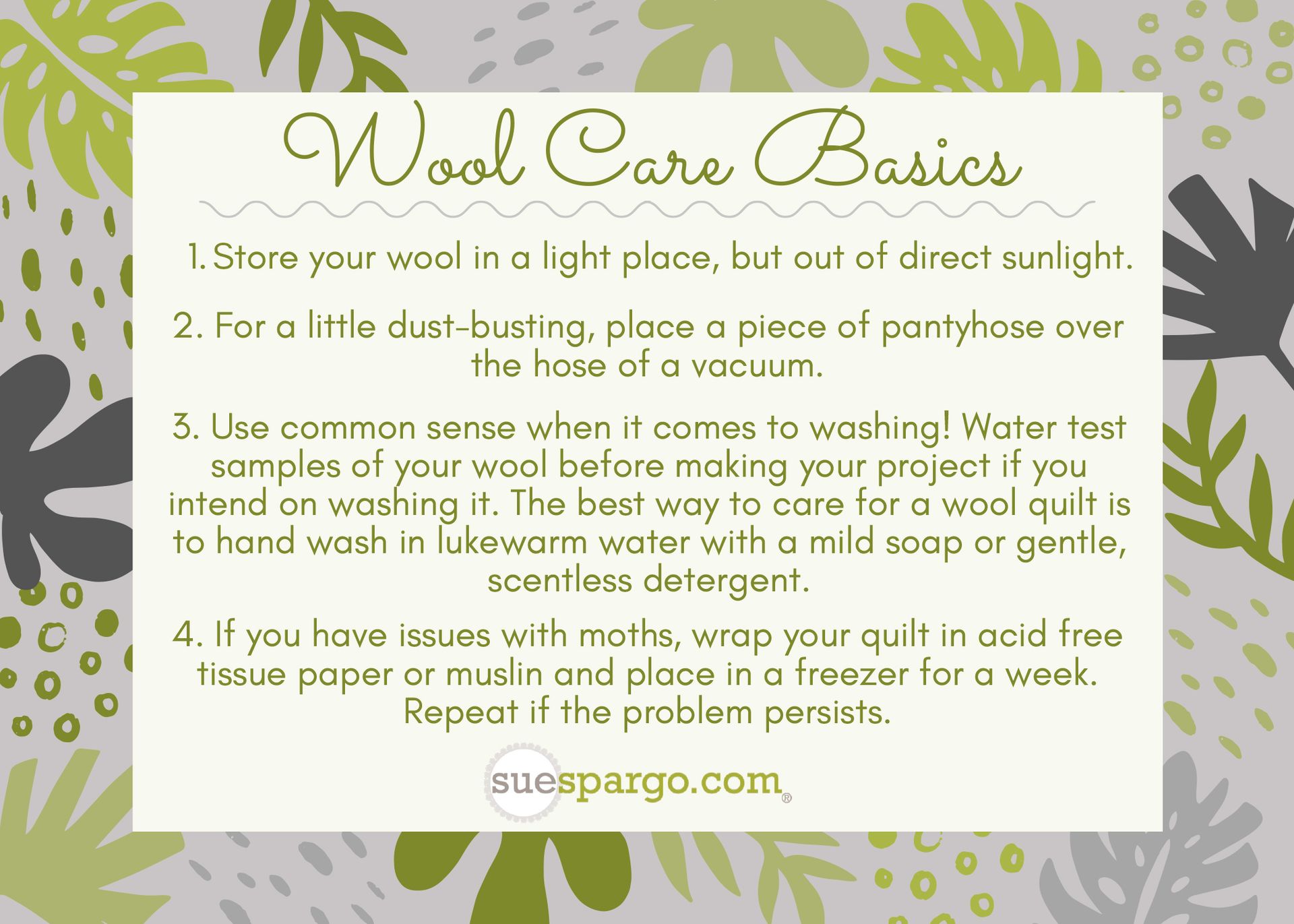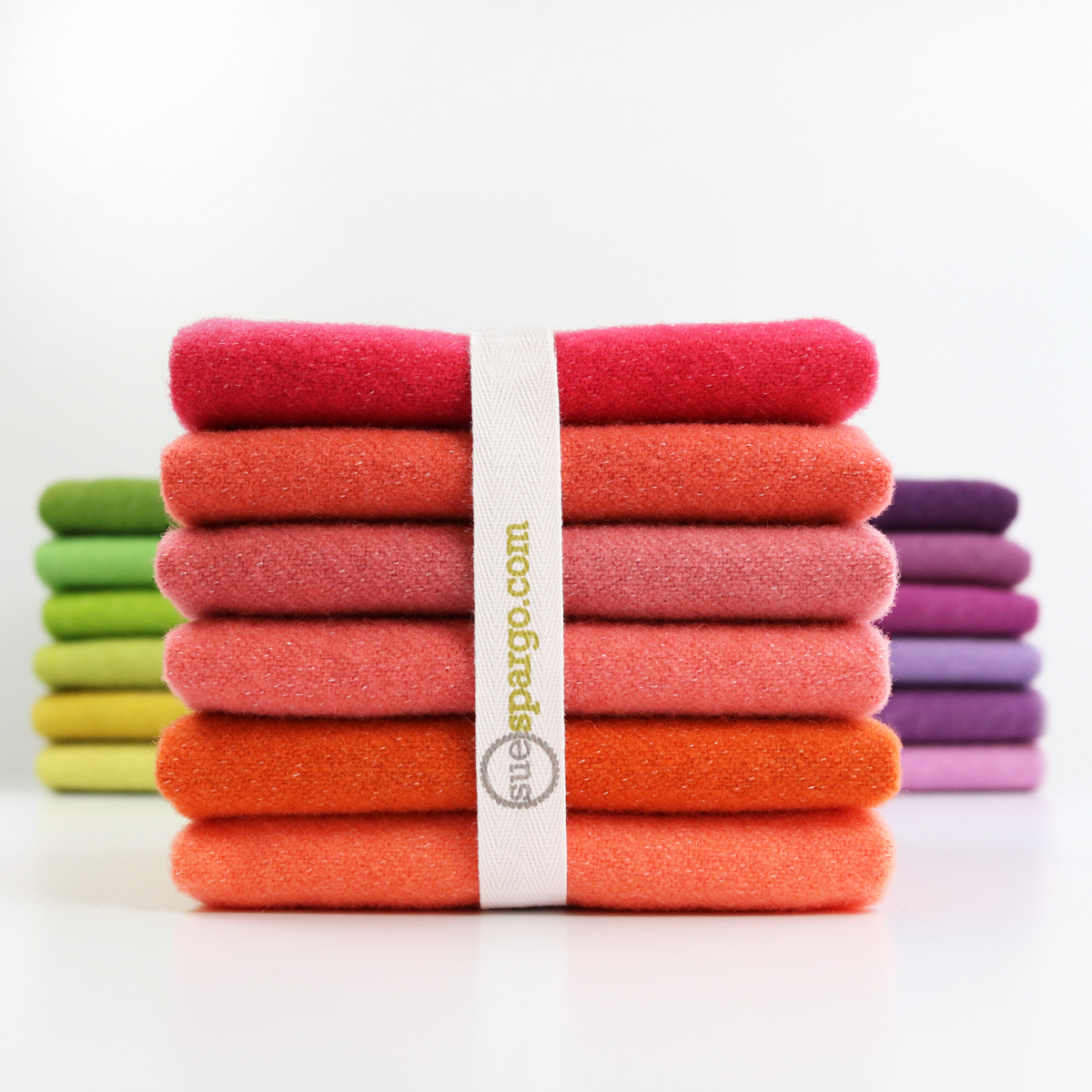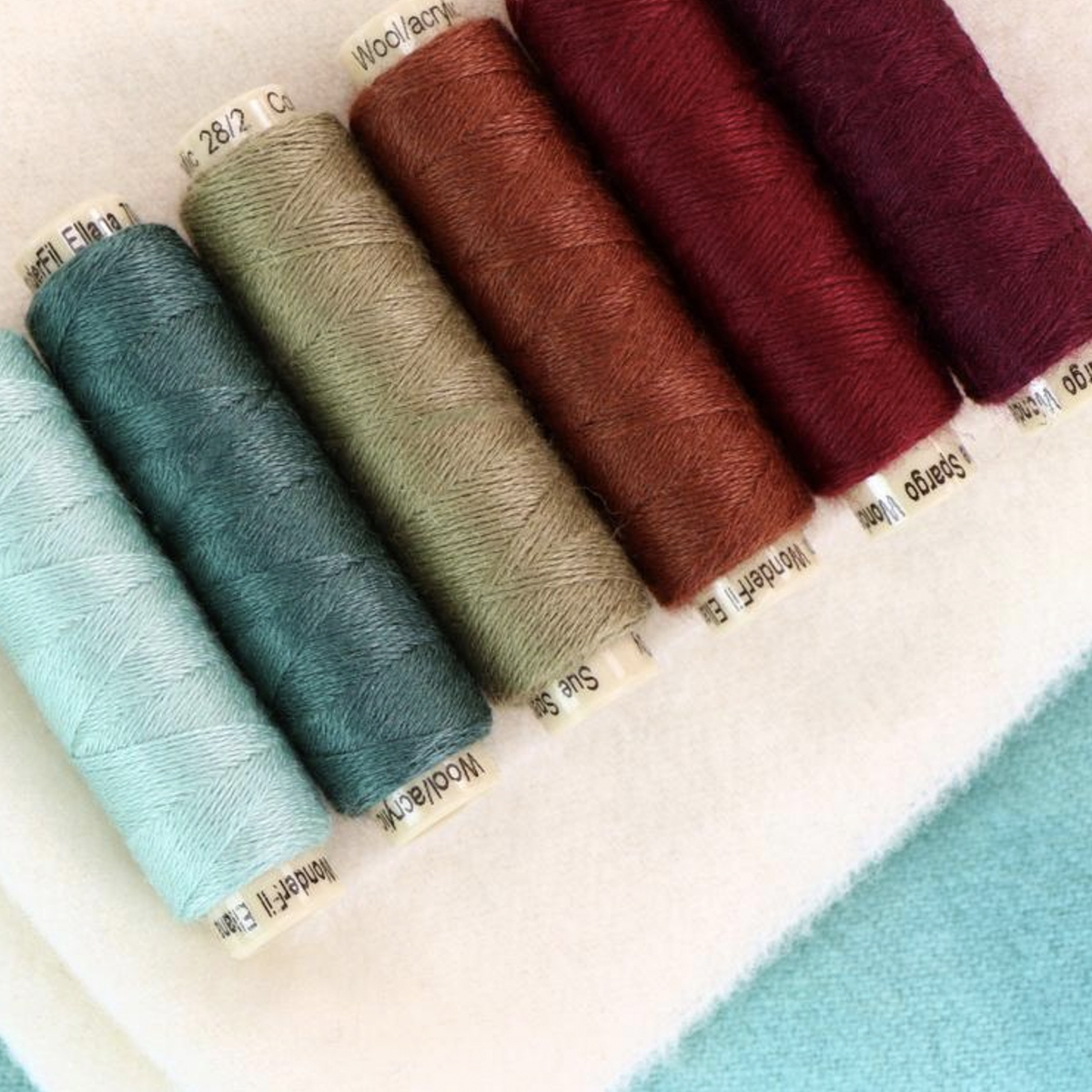It's no secret that we are head over heels for wool at Sue Spargo! We love producing it, dying it, printing on it, stitching on it, creating with it, and talking about it! With so much to know about wool, we have compiled a list of the most commonly asked questions. So, let's get into it!
What makes a wool good for appliqué?
For appliqué, you want 100% wool, as it felts up tightly. This prevents the edges from fraying, so you can use a short whipstitch. If the edges fray, you have to make a deeper stitch, which will make the stitches visible.
What is the difference between 100% wool and felt?
Wool is a natural fiber that goes through a vigorous process before it's transformed into a woven, ready-to-dye textile. With the exception of some textures, all of our hand and mill dyes are 100% wool. Felt is a dense, non-woven textile generally composed of synthetic materials that are pressed together by moisture, heat, and pressure.
What's the 411 on wool thread?
Ellana is the only thread we use for wool appliqué, with a whipstitch. It is a 12wt, 50/50 blend of wool and acrylic. The acrylic has to be incorporated into the makeup of the thread in order to give it strength, while wool is the property that makes it fuzzy and matte. We select the closest matching thread to the piece we are appliquéing down and use a length no longer than 18" with a #24 Chenille needle. As we whipstitch the pieces in place, this thread coats the edges of the appliqué, creating an almost invisible stitch. Our goal is to make the applique as invisible as possible, so it does not detract from or fight with the embroidery.
If we were to use Perle cotton to appliqué the pieces in place, then come back and embroider or embellish, things would become busy and confusing, as there would already be a decorative stitch in place. If we were to use a cotton thread, its sheen would make the stitch visible, and it would cut into the edge of the appliqué.
What is the importance of using the correct size needle?
Using the right tool for any job, project, or craft is critical, so we would answer the above question simply, "very important!"
If we think about the task or job of a needle, it would rank as the most important tool in the execution of handwork. This is the tool used for each and every stitch we create, so why are we struggling and using the incorrect size, cheapest, most dull needle, or one that's from grandma's rusted collection? Not only is it vital in the execution of stitches, but also in the care of our hands. You should never be continuously struggling to pull threads through, and if you do you're likely using the wrong needle. Handwork should be enjoyable; you have to invest in the appropriate needle to get the job done with ease. We have worked hard to make this simple by color-coding our needle tubes to match the core of the coordinating size of our Eleganza Perle Cotton Threads (see tutorial: Know Your Needles).
How do you wash wool?
This is a question we get asked a lot! If you complete a highly embroidered quilt, we would never recommend washing it. There are far too many variables at play such as hand dyed threads and embellishments, all that require different care. If a piece needs a little dust-busting, placing a piece of pantyhose on the end of a vacuum hose does the trick.
If you must wash, one of the first things to ask yourself is, how would you wash a wool sweater? Would you wash a brand new red garment with a white garment? Looking at the piece you've created, only you can answer if it would be safe to consider hand washing. Our hand dyed wools go through numerous washes, but cannot be guaranteed to be colorfast, as water and temperatures differ all over the world. Reds in particular can be very temperamental.
We always recommend doing a water test on a sample of all the wools, prior to making your quilt, if you intend on washing it. The best way to care for a wool quilt would be to hand wash in lukewarm water with a mild soap, such as Soak, or a gentle, scentless detergent, then lay flat to dry. You could potentially have it dry cleaned if you have a dry cleaner you know and trust. If you know your wool is 100% wool from the source, and there is no embroidery, you could potentially machine wash it on a gentle cycle in cool water. You will likely have some felting/shrinkage initially as the fiber becomes used to your machine and water.
What is the best way to store wool?
Always store wool and wool projects in light, but not direct sunlight. Places you want to avoid are dark areas, like a container under a bed, which is just an invitation for moths to lay eggs.
Are there any issues with moths?
We have never had a problem with moths and wool. Here at our studio and warehouse, we store thousands of yards of wool, wool quilts, samples, projects, kits, and wool scrap. Moth vs. wool becomes problematic when you use recycled wool or the wool becomes soiled with a protein like human or animal excretions (i.e., sweat, saliva, pet dander). Moths are actually not the nasty little culprits that eat your wool; it's the larvae from their eggs that munch on the protein. Since we use newly milled wool, the risk of cloth moths is virtually nil.
If you ever experience a problem with moths, a solution is to wrap your quilt in muslin or acid-free tissue paper and place it in the freezer for a week. You then need to unwrap it to check for any further activity. If you see some, repeat the process. Washing or dry cleaning does not kill the larvae.
Click on the image below for a printable PDF Wool Care Card.
Keep this card with your wool stash for quick reference.
Do you use fusible?
Never! Wool is expensive, so you would never want to glue any part of it together. As long as you use a wool that felts well, you should never need it to hold the edges together. Fusible irons the wool flat, so you lose all of the dimension that wool naturally creates—not to mention, it can be hard to needle through!
What batting do you use?
Dream Cotton, or Dream Wool, has been our go-to batting for years. For highly embroidered wool quilts, we tend to lean towards the Dream Wool batting, as it has a bit more loft and drape than the cotton.
What weight of thread do you recommend for machine quilting wool?
Machine quilting a wool quilt isn't much different than a cotton quilt, besides feel. Some of our favorite threads are Ellana (12wt) with a 50wt cotton, like Konfetti, in the bobbin. You would use a #16 topstitching needle with this combination and adjust the tension of your machine as needed. Ellana gives the quilt's final layer a very organic feel, while a 50wt cotton would give it more of a sheen. Invisifil is also a crowd favorite since you don't have to change thread colors with the quilt. For those that enjoy big stitch quilting, we recommend Eleganza Perle Cotton in sizes 8, 5, or 3.
How do you keep small shapes from fraying on the edges?
We use a 1/4" wool punch for our small circles, which provides the cleanest cut we can find. For small shapes, the quality of wool is critical. It has to be tight, well-felted wool. We never use textural wools (due to possible blends) for small shapes; we only use solids that we know will not fray. A good pair of serrated scissors is also a must. Our favorites are the KAI 4" Professional Series & 6-2/3" Professional Series. Rather than using a traditional whipstitch, some people prefer to use a stab stitch to stitch small pieces in place.
What can you use to hold wool in place other than pins?
To clarify, we want to point out that we use appliqué pins vs. sewing pins. Applique pins are tiny in comparison to regular sewing pins (3/4" in length vs. 1-3/4" - 2"), and are our go-to when it comes to wool appliqué. Very few pins are needed, as wool to wool naturally adheres. If we are working on a large project, we may thread baste, and on occasion, for quick application, we use Sewtites.
We discourage the use of staples, needle felting backgrounds, tag guns, or fusible, as the chance of damaging your wool is high.
What is the best way to remove freezer paper from wool?
When applying freezer paper templates, use a dry (no steam), hot iron, applying just enough pressure to lightly adhere the template. Once your shape is cut out, gently peel off the freezer paper to remove it.
Is freezer paper used to stabilize wool during cutting?
Not necessarily. Since freezer paper is easily adhered to and removed from wool, it works as a guide during cutting rather than a stabilizer. Freezer paper is a quick, efficient, and inexpensive way to make templates. They are reusable, and you can write on them! Several years ago, we realized that freezer paper available in grocery stores would no longer adhere well to wool, and we made a switch to packaged freezer paper. regular packaged freezer paper, which is ideal for general wool applique, along with heavy duty. Heavy duty freezer paper is great for multiple images, such as a repetitive sampler, or if you want to keep a particular template for a longer period of time. It's also what we use for velvet applique circles (see tutorial: Velvet Applique Circles).
After cutting out your appliqué pieces, do you embroider them first, then appliqué them to the background, especially if there are multiple layers?
No, appliquéing all the pieces in place is always the first step in our projects, as it is the foundation that you will then embellish on. If you're not using fusible, it shouldn't be difficult to needle through layers when embroidering. In addition, many of the embroidery stitches are in places that cover the whipstitch or border an appliqué piece, so they must be done after the appliqué step is complete.
How do you layer appliqué pieces that touch one another without creating a bump?
Rather than whipstitching the edge of the underlay, we sometimes attach longer edges with a running stitch in the center of the seam allowance. This provides a more flush surface to appliqué the overlay to. Also, when appliquéing the overlay, appliqué only to the underlay, not through it to the background.
We hope we were able to answer some questions you may have had about wool and that you are just as excited about it as us!
Create


